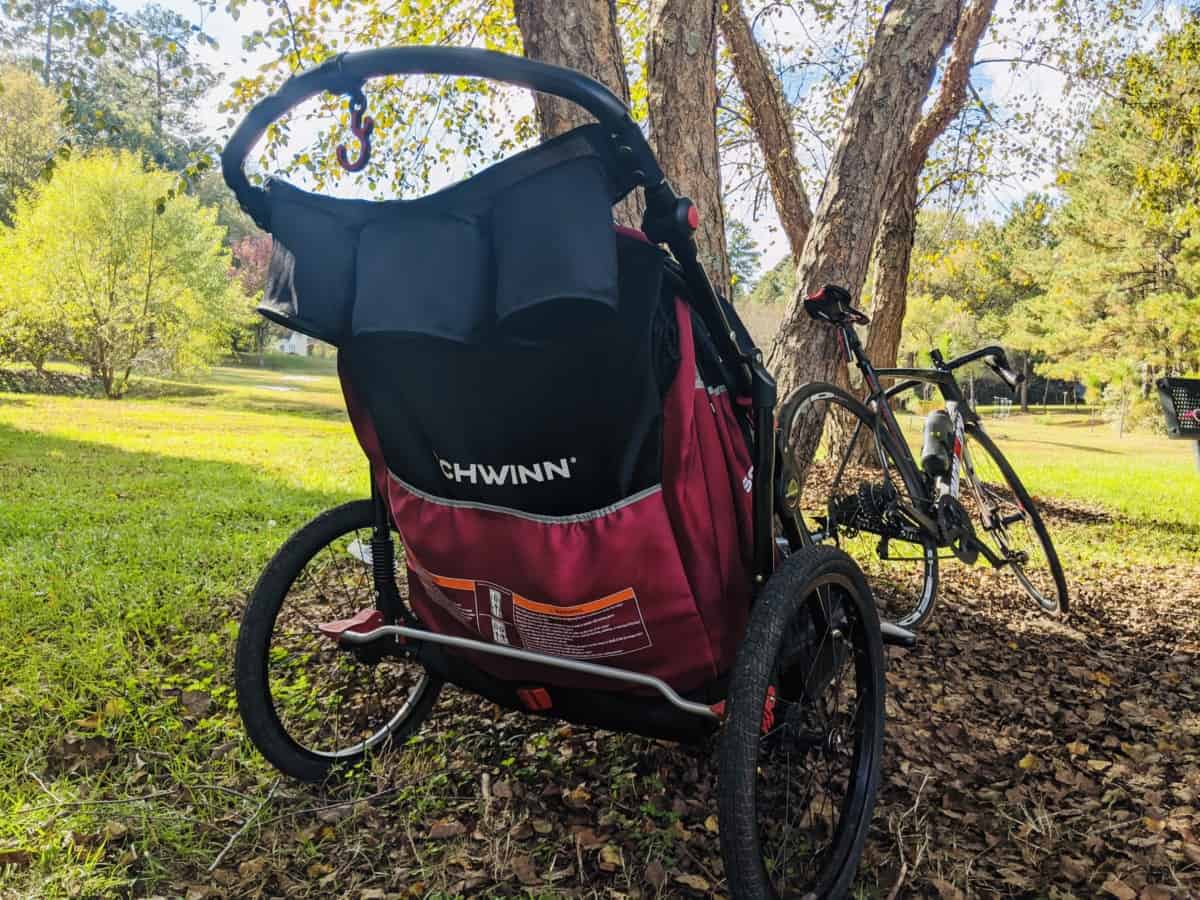“Pulling a bike trailer sounds like hard work! How heavy are they actually?”
There are many things to consider when buying a bike trailer, from how much they cost, to how much weight they can carry, to how much they weigh.
I’ve been towing my two kids in bike trailers since 2014, so I know exactly how important the weight of the trailer can be!
If you want to know exactly how much extra weight you will be pulling behind you, then this article is for you.
The average bike trailer weighs from 20 to 40 lbs (or 9 to 18 kg). Factoring in the weight of a child and cargo, the total weight being pulled ranges from 40 to 100+ lbs (or 18 to 45 kg). If you plan to do longer rides that entail hills and lots of stop-and-go riding, then the weight of the trailer will be a significant consideration.
Here is a quick table of 10 of the most popular bike trailers and their corresponding weights:
| TRAILER BRAND | WEIGHT | SEATS | PRICE RANGE |
| Burley Bee | 19.95 lbs (9.1 kg) | Double | Around $300 (Amazon link) |
| Burley Minnow | 21.9 lbs (9.9 kg) | Single | Around $330 (Amazon link) |
| Thule Cadence | 22 lb (10 kg) | Double | Around $330 (Amazon link) |
| Schwinn Trailblazer | 23.80 lbs (10.7 kg) | Single | Around $120 (Amazon link) |
| Allen Sports Deluxe | 24 lbs (10.8 kg) | Double | Around $120 (Amazon link) |
| Instep Sync | 24.5 lbs (11.1 kg) | Single or Double | Around $120 (Amazon link) |
| Thule Coaster XT | 26 lbs (11.8 kg) | Double | Around $430 (Amazon link) |
| Thule Chariot Cross | 28 lbs Single (12 kg) or 32 lbs Double (14 kg) | Single or Double | Around $1080–$1180 (Amazon link) |
| Schwinn Joyrider | 40 lbs (18 kg) | Double | Around $360 (Amazon link) |
| Schwinn Rascal Dog Trailer | 27 lb (12.2 kg) | Dog Trailer | Around $145 (Amazon link) |
This article is on the topic of how much bike trailers weigh, which is very different from how much weight can bike trailers carry. Read the in-depth article about weight capacities here.
To find out how to make riding with a bike trailer even easier, keep reading!
If you’re considering exactly how much extra weight you will be pulling around, then it’s important to consider a few factors:
- The average bike trailer weighs around 20–40 pounds, depending on whether you are using a single or double bike trailer.
- Other factors would include the material from which the trailer is made and the brand of the bike trailer. You can always check the product description page of a specific bike trailer to know the exact weight.
- Be sure to factor in the weight of your child, children, or pet.
- You can add about 10 pounds of cargo to the equation. It’s always nice to have snacks, diapers, extra clothes, books, or toys for the kids, or whatever you need.
Total Weight = Bike Trailer Weight + Child(ren) Weight + Cargo
The total can add up quickly, from 40 lbs to 100+ lbs.
If you’re an avid cyclist, you know that’s a lot of added weight! Just imagine what gaining that amount of fat or muscle would do to your hill climbs.
Why does the weight of the bike trailer matter?
The more weight you’re pulling behind you, the harder it will be on your legs. Pulling an additional 40+ pounds of weight (the bike trailer plus any precious cargo) is significantly more difficult than pulling just yourself.
Since average bike trailer weights can range from 20 to 40 lbs, the 20 extra pounds can make a big difference. Just imagine how it would feel riding if you suddenly put on 40 lbs of weight. Not easy!
But there’s good news! The good news is that pulling extra weight with a bike trailer is very different from adding extra body weight, because the center of gravity of the bike trailer is on the wheels of the trailer, and the weight on body weight is on your bike.
What affects the weight of a bike trailer?
Seeing as bike trailers can range from weighing 20 lbs on the lower end to 40 lbs on the highest end, it makes you wonder what causes the difference in weight. The main cause of bike weight differences comes down to two things:
- Double or single-seat trailer
- Trailer-only or multi-use trailer
1. The seat capacity affects the trailer weight (single or double)
Whether a bike trailer can hold two riders or just one will largely determine the size and weight of the trailer.
With a single-seat model, you get a minimalist style and optimized weight to pull around. On the other hand, a double-seat will be significantly heavier, but can carry a lot more weight (around 80–100 lbs weight capacity).
2. The materials of the frame affect the trailer weight
On the higher end of bike trailers, such as products by Thule and Burley, they typically have a lower weight than entry-level trailers.
3. Function affects the trailer weight
There are a variety of types of trailers that have different functions and therefore weigh differently. The two main types of bike trailers include:
- Trailer-only bike trailers (lightweight)
- Multi-purpose bike trailers (heavier)
Obviously, the trailer-only bike trailers are minimal by design and do not require extra pieces, attachments, or wheels that the multi-purpose trails come with. A multi-purpose trailer is heavier because it is designed to convert for strolling, jogging, or even skiing.
How you use a bike trailer is more important than the weight
With all this being said, the weight of the bike trailer is not nearly as important as the function of the bike trailer.
If your primary use of the trailer will be for occasional recreational rides with the family on paved bike paths, then you can comfortably get away with any bike trailer.
On the other hand, if you plan to do longer rides that entail big hill climbs and lots of stop-and-go riding, then the weight of the trailer will be a significant consideration. I would recommend one of the good-quality lightweight trailers outlined below.
How much weight can a bike pull?
Theoretically, the rider of the bike can pull a load of almost unlimited weight, given the right equipment and Olympic leg strength. Practically speaking, however, there are three main factors that determine how much weight a bike can pull:
- Bike frame durability
- Bike trailer’s weight limit
- Time riding
Your fitness level matters less and less as the second two factors become optimized.
For instance, if the trailer is a lightweight model and you’re just going out for short recreational rides on weekends, then a healthy rider at any fitness level will be able to comfortably pull a bike trailer.
On the other hand, if you’re pulling a significant amount of weight (100+ lbs), and you’re riding long distances (5+ miles), and your body is not accustomed to cycling, then you will have a harder time covering the distance.
Regarding the durability of the bike frame, bike trailer manufacturers design their trailers to safely attach and be pulled by any type of bike. In fact, I have successfully pulled more than 100 lbs of trailer weight with two kids using a cheap $120 Instep bike from Amazon.
Which leads us to the next common question…
What kind of bike do I need?
In short, most bikes are suitable to pull a bike trailer. Because there are so many different types of bikes out there (road bikes, cruisers, e-bikes, etc.), bike trailer companies do a good job at providing attachments and manuals to help riders make informed decisions before buying the trailer.
Bike trailers typically attach to the axle of the rear wheel of the bike. In rare cases, the trailer attaches to the seat post of the bike.
In most cases, you’ll be able to easily attach your new bike trailer right out of the box, with all accessories included. Specifically, if your bike’s rear wheel has a standard quick-release (skewer that goes through the center of the wheel), then most trailers will attach easily to your bike.
What types of bikes are not compatible with bike trailers?
Some types of bikes may require a simple adapter in order to attach the trailer.
Typically, bikes that have thru-axle wheels or hooded-style dropouts may require an adapter. Thru-axles of at least 12mm in diameter will not fit through the hole of the coupler attachment. If you have disc brakes, be sure to check if you have a 12mm thru-axle. If so, then a simple coupler attachment purchase will do the trick. Read more about disc brakes and bike trailers here.
To read more about bike trailer compatibility, check out this article: Can Bike Trailers Be Used On Any Bike?
Read about trailer compatibility for:
Is it hard to pull a bike trailer?
Pulling an additional 40+ pounds of weight (the bike trailer plus precious cargo) is significantly more difficult than pulling just yourself.
The good news is that pulling a bike trailer is surprisingly easier than it seems. If you choose to ride on mostly flat, smooth roads, then you will barely even notice the bike trailer (but don’t forget it’s there!).
The only times you will really notice the extra to pull a bike trailer is when accelerating after coming to a stop, climbing a hill, and riding over long distances (whatever long is to you).
Seven tips to make pulling a bike trailer easier
There are seven easy ways you can make pulling a bike trailer significantly easier for you. Keep in mind that pulling a trailer is not as difficult as it sounds.
1. Remember the benefits of riding
Reminding yourself of the benefits of riding with your child will absolutely help with the mental aspects of pulling more weight. Shift your mindset from “this is so much harder” to “this is great exercise and my kid loves it!”.
Remember, you are putting down some serious power and getting better exercise due to the added weight. More importantly, your child is reaping all the benefits of being outdoors and learning the importance of cycling as a lifestyle.
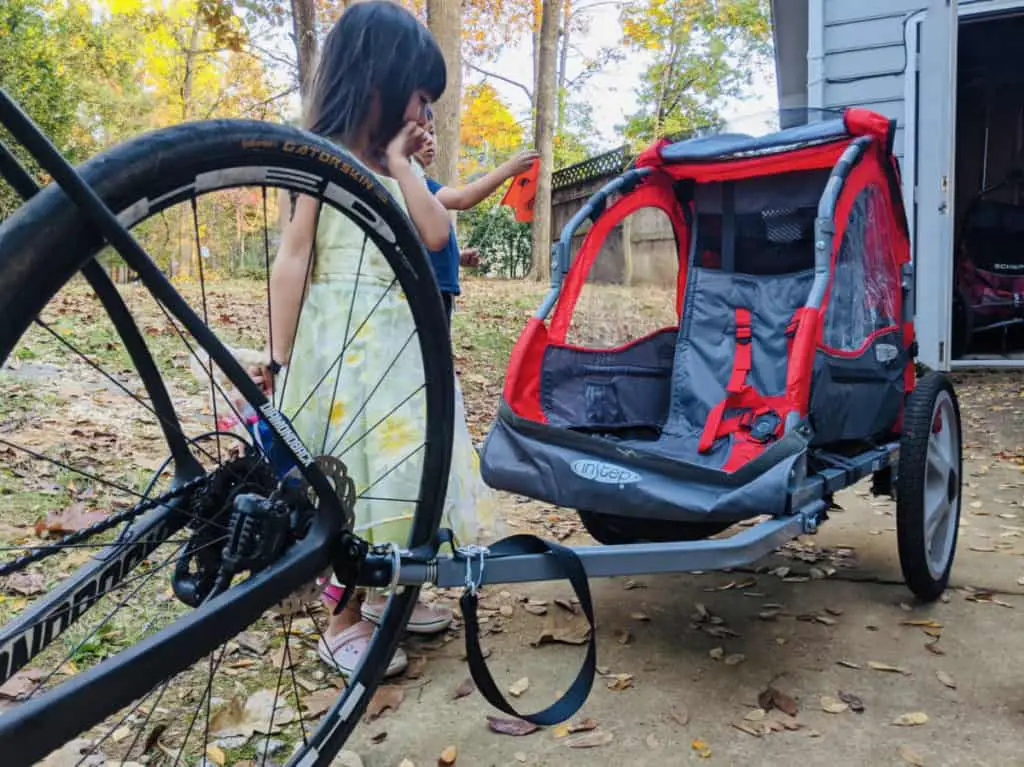
2. Realize that it will get easier
If you maintain a relatively low speed (under 10 mph), then pulling a bike trailer will become easier for you over time. Reminding yourself of this will help every time you face that massive hill in your neighborhood. It’s also helpful to remember that the added weight means better exercise for you!
3. Choose the optimal gear ration
Pedaling at a higher cadence will make pulling a bike trailer easier because you will not be over-exhausting your legs too early.
Especially on hills, choosing the optimal gear ratio is essential. It’s tempting to want to go fast and get to your destination quickly, but it’s actually safer and less difficult in the long-run to keep a higher cadence and just take it slowly.
On downhill descents, just cruise and give your legs a well-deserved rest.
4. Plan the flattest route possible
This one sounds obvious, but you’d be surprised by how many local backroads there are that you never knew existed until you looked it up on Google Maps. Any map app on your phone will be your best friend when mapping out your ride with the bike trailer. Google Maps can even estimate the difficulty of the ride by the gradients of hills on the route.
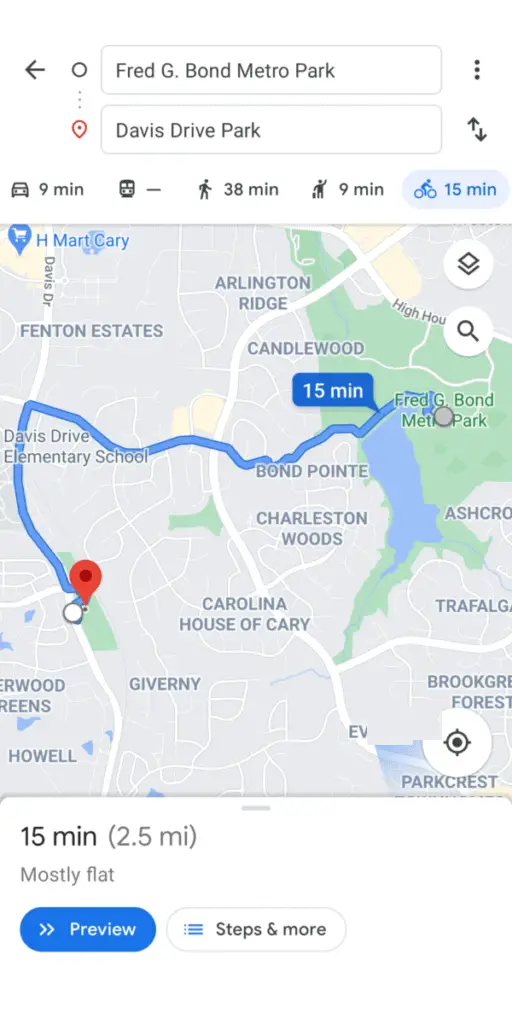
My family was living in a busy part of New Jersey when I first bought a bike trailer. I was immediately intimidated by the big hills and high traffic volume, until I took out Google Maps and actually found some very quiet, flat backroads that took me exactly where I wanted to go.
Go out on a solo ride before taking your bike trailer out to test the roads for safety and flatness. If you run into a few hills, just treat them as good training and they will get easier over time 🙂
5. Fill your tires, especially the rear tire
Deflated tires on your bike, as well as on the bike trailer, will make it much more difficult to pedal. Be sure to check your tire pressure before every ride.
Pro tip: inflate your rear tire to the maximum pressure to improve rolling resistance, since there will be more weight on the rear wheel from the bike trailer.
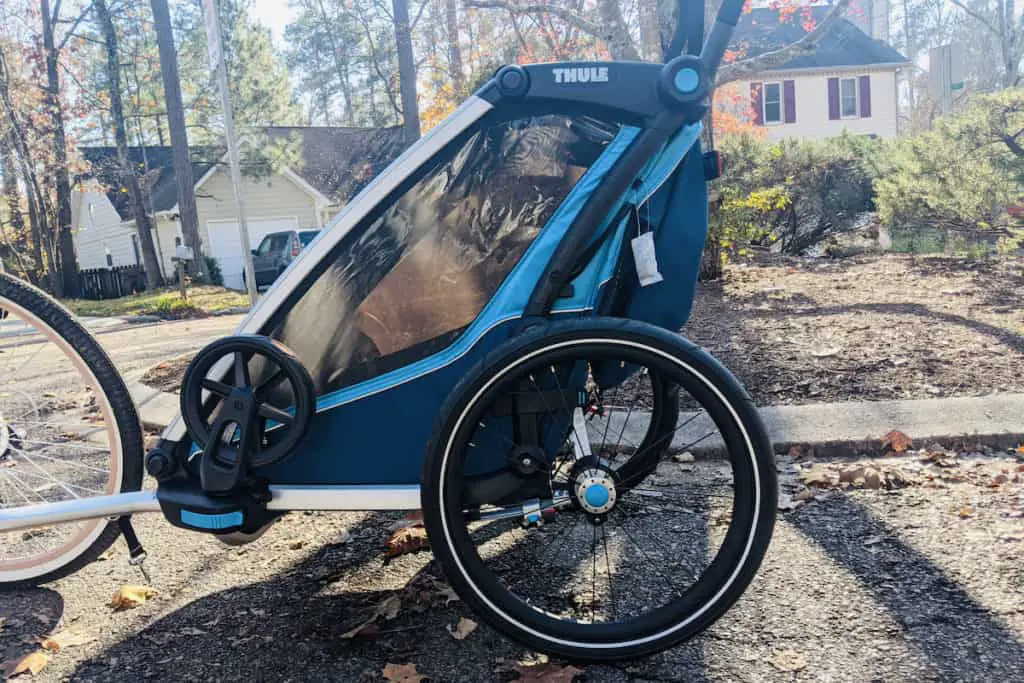
6. Try not to stop pedaling
Stop-and-go traffic is the single greatest time and energy waster. Try to plan ahead as much as possible and avoid stopping whenever you can. This could mean just slowing down earlier before a stop sign or crosswalk. You’ll learn very quickly that braking and starting up again are quite taxing on the legs.
7. Pace yourself, you’re pulling another person!
It sure is tempting to hit the ground running as soon as we hitch the bike trailer, but burning up your legs too quickly will not be fun on the way back.
Know your limits and just enjoy the ride. Keeping speeds under 10 mph (or 16 kph) is recommended to keep a safe and easy pace. After all, you’re pulling more than just yourself this time!
It might take some time to get used to pulling more than just yourself, but after about 3 or 4 rides, you’ll have a handle on it.
For more on making bike trailers easier, be sure to read: How Hard Is It to Pull a Bike Trailer with Kids?
Top 5 lightweight bike trailers
Here are the best 5 lightweight bike trailers that all weigh under 25 lbs. I’ve compiled this list with price as an important factor for most people. If you need further help choosing a bike trailer, check out my Ultimate Guide to Buying a Bike Trailer.
1. Burley Bee
Weight: 20 lbs

Price: Around $300 (check on Amazon)
Seats: Double
Stroller Conversion: No
Weight Limit: 80 lbs (36 kg)
The Burley Bee is a well-designed, high-quality, suprt lightweight, and budget-friendly bike trailer for frequent riders. It’s just 20 lbs and impressively light for the size of the frame.
With the reputable Burley brand and high-quality materials, the Burley Bee is one of the best bang-for-buck trailers for anyone looking for a trailer that is just really good at being a trailer.
Pros
- Affordable—A low price point for a high-quality Burley trailer
- Burley quality—A high-quality trailer that might turn into a robot
- Lightweight—Weighs just 20 lbs, which is half the weight of some trailers
Cons
- No stroller conversion—It’s a minimalist, lightweight trailer
I wrote a full review of using the Burley Bee, which you can check out here.
2. Thule Cadence
Weight: 22 lbs

Price: Around $330 (check price here)
Seats: Double
Stroller Conversion: No
Weight Limit: 100 lbs (43 kg)
A lightweight minimalist trailer with the highest quality that Thule has to offer, the Thule Cadence is a steal of a deal at under $350.
If you want the high-quality materials and customer service of Thule without having to pay high-end prices, then the Thule Cadence is a solid option. It does not have the stroller conversion features that I would hope to see on a trailer in this price range, but it is a solid minimalist trailer with large wheels and large interior space.
Pros
- Affordable—for such a high-end brand
- Double seats—wide, spacious bench-style seat
- Large 20-inch wheels—20 inches is the gold standard
- Large interior space—a comfortable amount of space for the kids
Cons
- No stroller conversion—It’s a minimalist, lightweight trailer
- Frame and cover quality—not as good as other Thule trailers
- Harness quality—not as good as other Thule trailers
3. Thule Chariot Lite
Weight: 25 lbs

Price: Around $1,000 for double (check on Amazon) and $900 for single (check on Amazon)
Seats: Double
Stroller Conversion: Yes
Weight Limit: 100 lbs (43 kg)
Best for active families who want the most out of their bike trailer, the Thule Chariot Lite is a top-of-the-line quality trailer that is worth every penny. Its large wheels and suspension feature make it a great option for gravel riding or mountain riding.
Although on the higher end of the price spectrum, the Chariot Lite is actually a few hundred dollars cheaper than its older brother, the Thule Chariot Cross. For that reason, the Chariot Lite makes the list of exceptional trailers and I would recommend it to someone looking for a trailer that can take a beating.
But why would anyone swing for such a pricey bike trailer?
The Chariot Lite comes with suspension, which adds extra comfort to your child on rough terrain. If you plan on any gravel or mountain rides, then this trailer is ideal for your type of riding.
But if you’re just planning on recreational riding, then the Schwinn Joyrider does many of the same things for more than half the price.
Pros
- Highest-quality materials—Truly the best components on the market
- Suspension—Added comfort on rough terrain
- Double front wheels—Makes for an excellent stroller
- Lots of storage—It even comes with a pannier bag attached to the back
Cons
- Cost—It’s a top-of-the-line bike trailer and has suspension
- Complicated to assemble—It comes with a lot of attachments that are hard to understand at first
I wrote a full review of using the Thule Chariot Cross, which you can check out here.
4. Schwinn Trailblazer
Weight: 24 lbs

Price: Around $130 for Single, (check on Amazon), $200 for Double (check on Amazon)
Seats: Single or Double
Stroller Conversion: Yes on Double, No on Single
Weight Limit: 80 lbs (36 kg)
For budget-minded families that also want a bike trailer with great reviews, the Schwinn Trailblazer is hard to beat at under $150! There are two other noteworthy trailers that are in the same price range as the Trailblazer: the Instep and the Allen Sports Deluxe.
The reason I would recommend the Schwinn Trailblazer over those two options is simply because of the quality. They just don’t have the same level of durability and safety features that the Trailblazer offers.
The Trailblazer also comes in a double-seat capacity and stroller conversion for around $200. You can check out that model on Amazon here.
Pros
- Acceptable quality—for a budget trailer
- Double and single seats available—few trailers give both options
- Stroller conversion available—only on the double version
Cons
- Lower quality materials—budget trailer
- No stroller conversion—on the single-seater
I wrote a full review of using the Schwinn Trailblazer, which you can check out here.
5. Burley Minnow
Weight: 21 lbs

Price: Around $280 (check on Amazon)
Seats: Single
Stroller Conversion: No
Weight Limit: 75 lbs (34 kg)
A high-quality single-seat trailer at an affordable price, the Burley Minnow is recommended if you aren’t looking for a trailer that converts to a stroller.
Why get a single-seater?
You might be wondering why someone would want a single-seat trailer as opposed to a double-seater. Apart from the obvious reason that some families will only be carrying 1 child, the reason a single-seater is a good choice is simply because of weight. The weight of a bike trailer can make or break your riding experience.
For example, if you’re going on a longer ride or climbing lots of hills, then the Burley Minnow will really come in handy. Also, having a single child sit alone in a double-seater is not as comfortable due to the weight distribution.
Pros
- Affordable—A low price point for a high-quality Burley trailer
- Lightweight—Weighs just 22 lbs, which is half the weight of some trailers
Cons
- No stroller conversion—It’s a minimalist, lightweight trailer
Conclusion
The added health benefits to you and your child often outweigh the difficulty of pulling a heavy bike trailer. In addition, the difficulty of pulling the bike trailer will decrease over time as you become stronger and follow some simple riding tips (outlined above).
You will get used to the extra weight very quickly and your legs will thank you for it. You’ll get stronger over time and, surprisingly, you won’t really notice the extra weight.
Unless you’re a bike trailer enthusiast and plan to do extended rides with your kids, then the weight of your bike trailer matters very little in comparison to how you use the trailer. I recommend just getting the trailer that best matches your lifestyle and functional needs.
With that said, if you do find yourself needing a lightweight bike tailer, then you can get any of the top-rated lightweight trailers on the market.
Need help finding the right bike trailer?
If you need help finding the right bike trailer for you, my recommended trailer for most people is the Swhinn Joyrider, which is an affordable double-seater that converts beautifully to a stroller. Check out my full review with photos here.
Check out the Ultimate Guide to Buying a Bike Trailer for more help with choosing a trailer. I also have compiled a list of the top bike trailers for every common situation, which you can check out here.
Ride on!
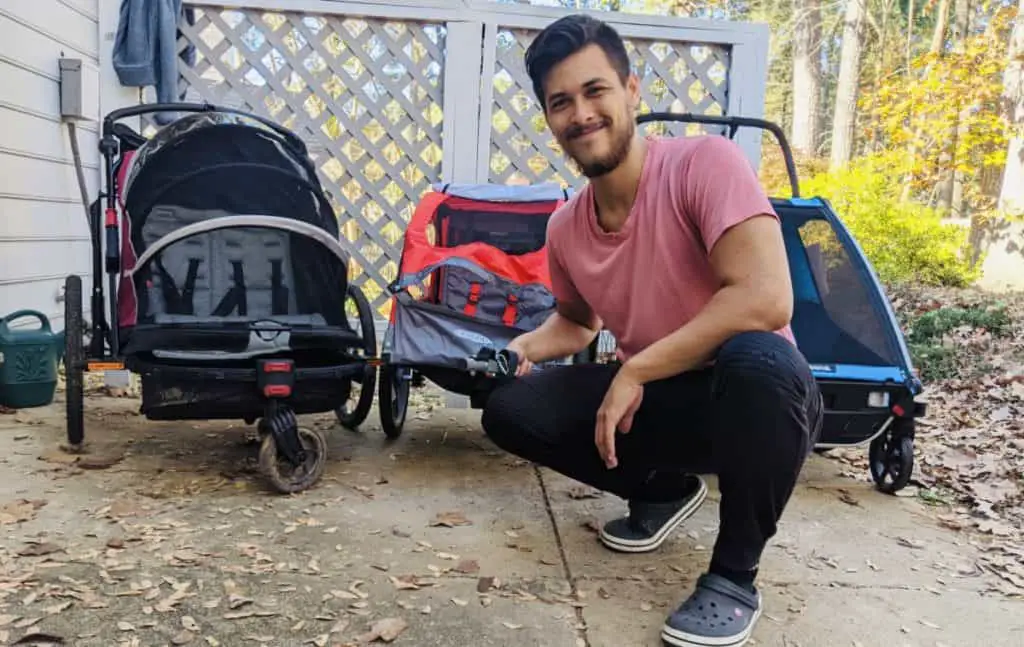
Also read:

